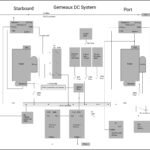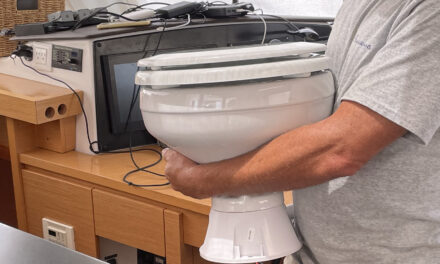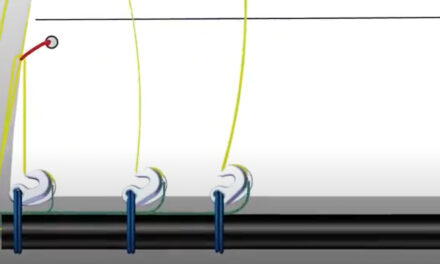Living on a sailboat means we’re always interested in how much available battery power we have. We typically avoid marinas so we don’t have any power except what we generate ourselves. Our sources of power are solar panels, diesel generator, engines which propel the boat, and a hydro-generator which creates energy from the flow of water going by when we’re under sail. Some boats also have a wind generator, but we haven’t taken that step yet. Any energy we generate must be stored or it will be lost. Our storage is a large battery bank. How large? Our bank is like 15 car batteries. For our non-electrical readers, batteries are rated in ampere hours (Ahrs). An ampere (A) is a measure of current and the battery rating tells you how long the battery can supply the current. Gémeaux has a 600Ahr battery capacity, which means we can supply 25A of current at 12V for 24 hours. Another way to say express the capacity is we can supply 300W for 24 hours. Just for reference, a typical household refrigerator uses 300W.
The stated battery capacity, however, is not necessarily what you end up getting. Everybody has the experience of running the car battery down and then finding the level is so low that it will not take a charge. This is because typical storage batteries that use lead-acid chemistry don’t like to be heavily discharged. They love being topped up and staying there. The more often you deeply discharge the batteries, the shorter their lifespan. To maximize their life, the key is not to discharge them very much. On Gémeaux, we had a rule not to discharge the batteries more than 70% of their capacity. This meant we didn’t have 600Ahrs but only 180Ahrs of usable battery capacity. So, my example of 300W of continuous use in a day actually was only 90W, which was not very much power–less than one household incandescent light bulb left on for a day.
A couple of years ago, we greatly expanded our solar capacity, increasing it from about 300 to 1100W. Now, on a sunny day when the solar panels aren’t shaded by the mast or sails, we can generate 6000Whrs (sun only shines part of the day and we only get full output when the sun is high in the sky), which is almost enough to replace our full battery capacity each day.
Excited about our solar potential, we ditched the gas oven and replaced it with an electric microwave/convection oven. We also added an induction hotplate. They are both great, but they use a lot of power. Each morning, we had to start the generator before making coffee or toast. This ultimately led us to up our game and switch from lead-acid to lithium batteries. Unlike lead-acid, lithium batteries can be discharged almost completely. So, even without changing the battery capacity, we could nearly triple our available power by using lithium batteries. Lithium also charges faster than lead-acid so we could utilize more power during the day from our solar panels.
The easiest part of the battery conversion was physically swapping out the batteries. Out came four heavy 160Ahr lead-acid batteries and in went two much lighter lithium batteries. After that, it got complicated fast because lithium batteries charge very differently than lead-acid batteries and if they are charged incorrectly, they can catch fire. Each of the energy sources to the batteries had to be taught to talk nice to the batteries. Fortunately, the solar controller and inverter/charger (from the generator) are programable, so they were easy. However, the alternator for each engine that provides power and recharges the batteries when the engine is running (just like your car) is not programmable.
Our alternators on Gémeaux were rated for 115A of output. They rarely generated that much current because the lead-acid batteries couldn’t absorb energy that fast, but the new Lithium batteries could each suck in 200A of current. This might overtax the alternators. Furthermore, lithium batteries have safety circuits, which disconnect the batteries if they’re being abused. While this is a good thing (who wants a boat on fire?), it also means alternators must be protected because they don’t like their load suddenly removed, which would happen if the safety circuit was activated. So now two problems we had to solve–keep the new batteries from overtaxing the alternators and protect the alternators in case of sudden shutdown. The solution was a high-tech regulator for the alternators.
The old alternators had a built-in regulator, which monitored the voltage. If the voltage started to drop, it forced the alternator to work harder to increase the voltage. Likewise, if the voltage got too high, it dialed back the alternator to reduce the voltage. We had to rip that circuit out and replace it with an external regulator, which has the intelligence to deal with Lithium batteries. Our solution was a regulator from a company called Wakespeed, which could be programed for lithium batteries and communicate directly with the batteries on a network. That way if the batteries decided to shut down, they could give advanced notice to the regulators, which would turn off the alternators before their load was removed. But before the new regulators could be installed, the internal regulators had to disabled. It seemed silly to modify 8-year-old alternators, so instead we bought shiny new higher-power alternators touted to be better equipped to handle the load. We had heard horror stories about large alternators breaking mounting brackets or shredding belts, so while we got high-capacity alternators, we dialed their output down to 50% of their rated output.
Now our project included new alternators, which were controlled by a separate box mounted away from the engines. The old alternators had just a battery connection. Now they needed a field connection and something to tell the regulator when the engine was turned on (of course there is no such thing as a key switch on our engine). This required lots of rewiring in the engine compartments and several phone calls to my friend Jim.
Because they charge differently, lithium cannot be interconnected with lead-acid. We still had a separate engine start battery, which is lead acid so it couldn’t be connected to the house batteries, but still needed to be charged. This required a solid-state DC to DC charger which was connected to the house batteries and energized when the engines were running. Yet another box, more wiring, and more programing.
There were some false starts and delays with parts, so the project ended up taking a month to finish the install. Finally, we were ready for try it out. Ten minutes into the test sail, the port alternator put out too much voltage, which caused the battery to disconnect and fried the alternator and some circuits on the boat. Back to the dock, another week to resolve, and we found ourselves questioning if we had made the right decision. Next was a passage from Florida to South Carolina, where we had yet another disconnect and yet another alternator fry and more electronics go up in smoke–not a good thing when you’re hundreds of miles offshore. For the next couple of weeks, I immersed myself in the details of batteries, regulators and communication between all parties. I thought we had chosen tried and true technology, only to find out we were on the bleeding edge. Why did we have problems when so many boats had lithium batteries?
The key difference was our system relied on a communication system between the battery and the regulator controlling the alternator called CANbus, which is the same communication system used in most cars to coordinate between the various devices running in the car. While using CANbus in a battery system wasn’t a new concept for boats, it was apparently was new that CANbus was the only communication. We didn’t have current sensors or a system disconnect wire, which typically would have controlled things (with lots of additional wires), now all that information came via the CANbus. As I dug into the system, I found lots of issues with the regulators. The current limits in the regulator were incorrect. The feedback loop limiting current to the battery had way too much gain, causing the alternators to oscillate from fully on to fully off. The battery disconnect warning message was occurring simultaneously with the disconnect and the regulators were mistakenly configuring themselves at the same address which confused them. While all these were indeed significant problems, they didn’t lead me to what actually caused the battery to disconnect on our offshore passage. Whatever that problem was still has the potential to reoccur.
To protect us from future occurrences of the problem, I installed a relay which disabled the regulators if the voltage from the alternators exceeded the battery’s specifications. Additionally, I hardwired a disconnect warning signal (separate from the CANbus) from the batteries so it would also disable the regulators. So far, these safeties are keeping the new battery system happy. I just never expected this project would require so much effort to make it work reliably.
Through all this troubleshooting, I received great support from the installer (Just Catamarans), but little to no support from the regulator and battery companies, which was very disappointing. While I think both products have great potential, there are still many rough edges, and more work is required for the system to work correctly.
All in all? Onboard Gémeaux, we now have dramatically more available power. This translates to less generator usage and less worrying about how much energy is in the batteries. Converting to lithium batteries was a great decision, albeit painful process to implement.











